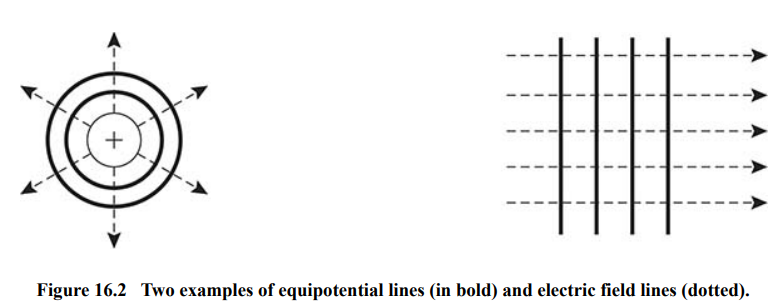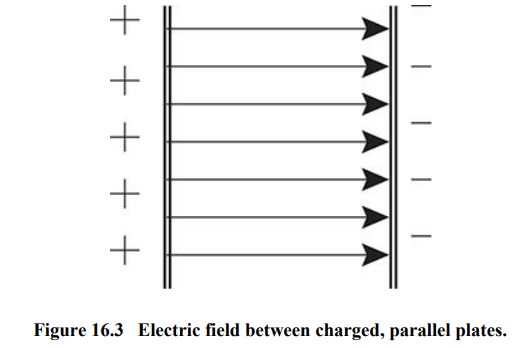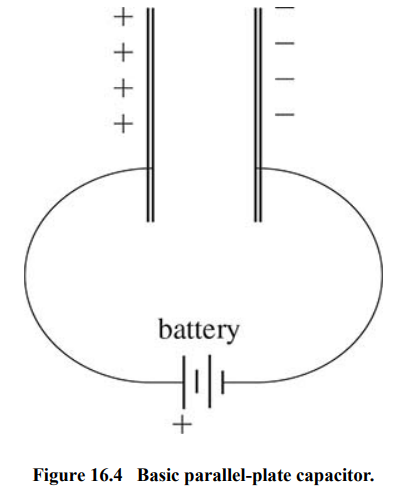Electrostatics
Key Ideas
- The electric force on a charged particle is qE, regardless of what produces the electric field.
- The electric potential energy of a charged particle is qV.
- Positive charges are forced in the direction of an electric field.
- Negative charges are forced in the direction opposite the field.
- Positive charges are forced from high to low potential.
- Negative charges are forced from low to high potential.
- Point charges produce non-uniform electric fields.
- Parallel plates produce a uniform electric field between them.
- An electric field is a vector, and electric potential is a scalar.
Electric Charge
- All matter is made up of three types of particles: protons, neutrons, and electrons.
- Protons have an intrinsic property called a positive charge.
- Neutrons don’t contain any charge
- Electrons have a property called negative charge.
- When an object has more protons than electrons, though, it is described as “positively charged”; and when it has more electrons than protons, it is described as negatively charged.
- Like charges repel; opposite charges attract.
- Two positively charged particles will try to get as far away from each other as possible.
- A positively charged particle and a negatively charged particle will try to get as close as possible.
- An induced charge occurs when an electrically neutral object becomes polarized—when negative charges pile up in one part of the object and positive charges pile up in another part of the object.
Electric Fields
- Field: A property of a region of space that can apply a force to objects found in that region of space
- A gravitational field is a property of the space that surrounds any massive object.
- There is a gravitational field that you are creating and which surrounds you, and this field extends infinitely into space. It is a weak field.
- The Earth, on the other hand, creates a strong gravitational field.
- Electric Field: A property of a region of space that applies a force to charged objects in that region of space. A charged particle in an electric field will experience an electric force.
- The electric field is a vector; so, electric fields are always drawn as arrows.
- The units of E are newtons/coulombs, abbreviated N/C.
Force of an Electric Field
The force felt by a charged particle in an electric field is described by:
F = qE
The force felt by a charged particle in an electric field is equal to the charge of the particle, q, multiplied by the electric field value, E.
The direction of the force on a positive charge is in the same direction as the electric field; the direction of the force on a negative charge is opposite the electric field.
Electric Potential
A charged particle in an electric field can have electrical potential energy.
Electric Potential: Potential energy provided by an electric field per unit charge; also called voltage.
Electric potential is a scalar quantity. The units of electric potential are volts. 1 volt = 1 J/C.
Equipotential Lines: Lines that illustrate every point at which a charged particle would experience a given potential.

On the left, the electric field points away from the positive charge. At any particular distance away from the positive charge, you would find an equipotential line that circles the charge.
On the right is a uniform electric field. The equipotential lines are drawn perpendicular to the electric field lines.
Special Geometries for Electrostatics
Parallel Plates
If you take two metal plates, charge one positive and one negative, and then put them parallel to each other, you create a uniform electric field in the middle.

The electric field between the plates has a magnitude of

V is the voltage difference between the plates.
d is the distance between the plates.
Charged parallel plates can be used to make a capacitor, a charge-storage device.

The space between the plates prevents any charges from jumping from one plate to the other while the capacitor is charged.
The amount of charge that each plate can hold is described by the following equation:
Q = CV
Q is the charge on each plate
C is called the “capacitance,”
The capacitance is a property of the capacitor you are working with, and it is determined primarily by the size of the plates and the distance between the plates, as well as by the material that fills the space between the plates.
The units of capacitance are farads, abbreviated F; 1 coulomb/volt = 1 farad.V is the voltage across the plates.

A is the area of each plate, and d is the distance between the plates (in m).
The term ε0 (pronounced “epsilon-naught”) is called the “permittivity of free space.” TThe value of ε0 is 8.84 × 10–12 C/V·m.
Point Charges

Q is the charge of your point charge
ε0 is the permittivity of free space
r is the distance away from the point charge
Second, the electric potential at some distance away from a point charge:

And third, the force that one point charge exerts on another point charge:

Q1 is the charge of one of the point charges, and Q2 is the charge on the other one. This equation is known as Coulomb’s Law.
Gauss’s Law

The electric flux, ΦE , equals the electric field multiplied by the surface area through which the field penetrates.
Flux only exists if the electric field lines penetrate straight through a surface.
If an electric field exists parallel to a surface, there is zero flux through that surface.
Gauss’s law states that the net electric flux through a closed surface is equal to the charge enclosed divided by ε0 .

ONLY use Gauss’s law when the problem has spherical, cylindrical, or planar symmetry.
First, identify the symmetry of the problem.
Then draw a closed surface, called a “Gaussian surface,” that the electric field is everywhere pointing straight through.
The electric field inside the conducting sphere must be zero everywhere.